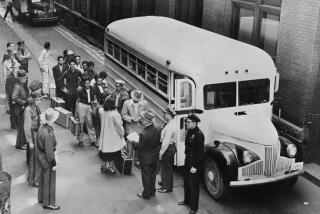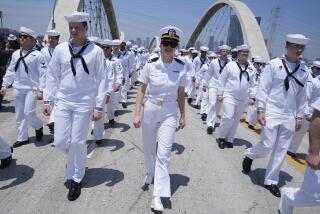Merchant Seamen to Salute Themselves With Statue
- Share via
Many of them were teen-age boys, too young to enlist in the military, but old enough to get caught up in the patriotic fervor that swept the country after the Japanese attack on Pearl Harbor.
So they looked for other avenues to war, and they found them at sea.
“When you are young like that, you don’t fear anything, you are just looking for some action, too,” said William Schwab, who in 1941, at age 16, left high school in Wilmington for the engine room of a commercial cargo ship, a job that took him around the world delivering supplies to Allied forces. “People wanted to be patriotic.”
The civilian merchant seamen took a battering at sea. More than 650 of their ships were sunk during World War II, more than 5,600 seaman were killed--a casualty rate the U.S. Maritime Administration says is second only to the Marine Corps--and 600 men were taken as prisoners.
Denied Veterans’ Status
Despite their wartime role, merchant mariners have been denied veterans’ status by the federal government, and perhaps more symbolically, have been excluded from national memorials honoring heroes of the war. For four decades, merchant mariners have bemoaned their lot as forgotten warriors.
Now, tired of waiting for recognition from Washington, a group of seamen from the Los Angeles area has decided merchant mariners should honor themselves.
The American Merchant Marine Veterans Memorial Committee, a group of local seamen based in Wilmington, has commissioned a 20-foot bronze statue depicting two merchant seamen climbing a Jacob’s ladder after making a rescue at sea.
The statue, the first national memorial to merchant seamen in the United States, will be mounted next May on Maritime Day on an 8,400-square-foot base in John S. Gibson Jr. Park, adjacent to the Los Angeles Maritime Museum in San Pedro. The monument will honor merchant marine veterans from all wars.
Nationwide Response
“It is long overdue,” said Ted Kedzierski, branch agent for the Marine Engineers Beneficial Assn., and president of the memorial committee. “We are getting response from all over the country.”
Land for the memorial has been donated by the Los Angeles Department of Recreation and Parks, and last spring, the Los Angeles Board of Harbor Commissioners voted to contribute $100,000 toward the committee’s $700,000 fund-raising effort.
But most of the money for the memorial, which will include a circular pool and fountain and a sloping wall veneered in marble, is expected to come from private donors--primarily retired merchant mariners, their families and others associated with the maritime industry. In addition to the Harbor Commission’s donation, the committee has collected about $250,000 in private money.
Some committee members point proudly to the lack of federal funding for the project.
No Federal Money
“This is going to be done with citizen money,” said Richard G. Connelly, executive officer of the Southern California Chapter of the American Merchant Marine Veterans, a national organization of merchant mariners who were at sea during war. “Somebody asked me, ‘Why don’t you get some federal money?’ and my reply was, ‘They haven’t done anything for us up to this point, so why let them spoil a perfect record.’ ”
Robert Scheina, a historian for the U.S. Coast Guard, said merchant mariners have in large part been ignored by the federal government because they lack the institutional clout of the traditional military services.
“They don’t have a fraternity to promote their cause,” Scheina said. “Yet their role in World War II was extremely important . . . without their services, the Allied cause would have been very hard pressed.”
Walter Oates, a merchant mariner during World War II who works for the Maritime Administration in Washington, said many seaman manned guns alongside enlisted Navy men.
“These men risked their lives,” Oates said. “We had guys who tried to enlist, but many of them were 4-F (classified physically unfit for military service).”
The memorial committee has mailed about 54,000 brochures on the monument to merchant mariners throughout the country, and Connelly said the response has been one of both gratitude and pride.
Large Donations
“If you trace this thing back prior to the Revolution, you find that the founding of the American Navy was from merchant ships,” Connelly said. “John Paul Jones and John Barry were merchant marine first, Navy second. Everybody just feels there should be some form of recognition.”
Thirteen individuals have contributed $10,000 or more, including Richard Bara, Los Angeles port agent for the International Organization of Masters, Mates and Pilots, and his wife, Kay. The Baras, the first to make a contribution of this size, were awarded a two-foot replica of the statue by Mayor Tom Bradley for their contribution. The committee has promised replicas for the first 25 contributors of $10,000 or more.
Other donations have been several dollars or less, including one of $2.50 from a retired seaman living in a home for destitute sailors in North Carolina.
“He sent a hand-scribbled note that you can barely read apologizing for not having more to send,” said Connelly, who worked on two ships that were sunk in the North Atlantic Ocean by German submarines. “That meant more to the committee than some of the larger checks we got.”
Sons to Finish Job
Last year, the committee commissioned Jasper D’Ambrosi, an Arizona artist who was born and raised in Wilmington, to sculpt the memorial. D’Ambrosi, who sculpted the Arizona Vietnam Veterans Memorial in Phoenix, died last year before completing the mariners piece. His two sons, Michael and Mark, who studied under their father, have agreed to finish the work by November, although it will not be mounted on its base until spring.
While honoring the seamen of yesterday, it is hoped that the memorial will also ignite new interest in the maritime industry.
The American merchant marine, which boasted 168,000 men at the height of World War II, has been hit hard in recent years by foreign competition and the dwindling number of American cargo ships. Last year, according to federal statistics, the number of jobs on American ships had fallen to fewer than 14,000.
“We need to have more American flag vessels and more American merchant mariners,” said Charles T. Gibson, former director of government and community relations for the Port of Los Angeles. “This statue is a way of reaching out and touching people in a very friendly and loving way, showing not only the activities of the port, but of those that work in it.”
More to Read
Sign up for Essential California
The most important California stories and recommendations in your inbox every morning.
You may occasionally receive promotional content from the Los Angeles Times.













